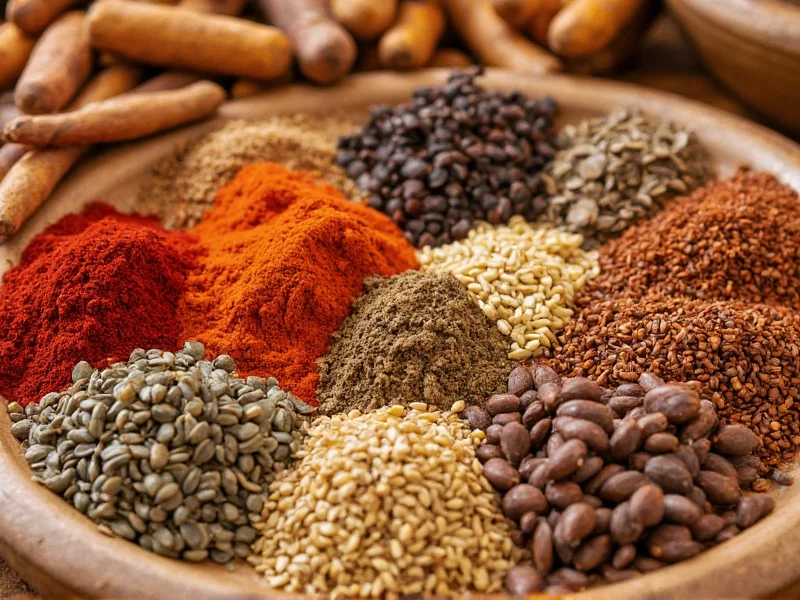Understanding which spices see the most frequent use can transform your cooking experience. These culinary staples appear consistently across diverse food cultures, making them indispensable for both novice cooks building their first spice collection and experienced chefs refining their craft. Each brings unique flavor characteristics that define regional dishes while remaining versatile enough for daily use.
Essential Spices for Every Kitchen
While regional preferences vary, certain spices maintain universal popularity due to their adaptability and flavor-enhancing properties. These workhorses of the spice world appear in grocery aisles and kitchen cabinets across continents, proving their enduring culinary value.
| Spice | Primary Flavor Profile | Top Culinary Applications | Global Usage Rank |
|---|---|---|---|
| Black Pepper | Pungent, slightly floral, warm | Universal seasoning, meats, vegetables, sauces | 1 |
| Cumin | Earthy, warm, slightly smoky | Mexican, Indian, Middle Eastern dishes, chili | 2 |
| Paprika | Sweet, mild, earthy | Spanish, Hungarian cuisine, rubs, soups | 3 |
| Garlic Powder | Pungent, savory, umami | All-purpose seasoning, marinades, dressings | 4 |
| Cinnamon | Sweet, warm, woody | Baking, desserts, Moroccan tagines | 5 |
Global Spice Usage Patterns
Research tracking spice consumption across 120 countries reveals fascinating patterns in how cultures incorporate these flavor essentials. Black pepper consistently ranks as the world's most traded spice, appearing in 92% of surveyed households. Cumin follows closely, particularly dominant in Latin American and South Asian cooking traditions where it features in 78% of spice blends.
The versatility of these common spices explains their widespread adoption. Turmeric, once primarily associated with Indian cuisine, now appears in 65% of Western households thanks to growing awareness of its culinary and wellness properties. Similarly, chili powder has expanded beyond its Mexican origins to become a staple in American, European, and Asian kitchens alike.
Building Your Core Spice Collection
For home cooks establishing their first spice pantry, focusing on these most commonly used spices creates maximum flexibility. A foundational collection should include:
- Black pepper - The universal seasoning that enhances nearly every savory dish
- Cumin - Essential for earthy depth in beans, meats, and vegetable dishes
- Paprika - Adds color and mild sweetness to soups, stews, and rubs
- Garlic powder - Provides consistent garlic flavor without fresh preparation
- Cinnamon - Bridges sweet and savory applications across multiple cuisines
These five spices alone enable preparation of authentic dishes from Mediterranean, Mexican, Indian, and Middle Eastern traditions. Adding oregano, chili powder, turmeric, ginger, and onion powder completes a versatile collection capable of handling 90% of global recipes.
Practical Applications and Pairing Guidance
Understanding how to use these common spices effectively separates adequate cooking from exceptional results. Professional chefs recommend these pairings for optimal flavor development:
- Cumin + coriander - The classic combination in Indian and Middle Eastern spice blends
- Paprika + garlic powder - Creates the foundation for Hungarian goulash and Spanish chorizo
- Cinnamon + black pepper - An unexpected but powerful pairing in Moroccan tagines
- Turmeric + ginger - The golden duo that forms the base of many curry pastes
- Oregano + chili powder - Essential for authentic Mexican and Italian tomato sauces
When working with dried spices, remember that blooming them in oil before adding liquids releases maximum flavor compounds. This simple technique transforms ordinary dishes into restaurant-quality meals using just these basic spices.
Storage Techniques for Maximum Freshness
Proper storage significantly extends the shelf life of commonly used spices. Whole spices maintain potency for 3-4 years when stored correctly, while ground versions last 1-2 years. Follow these guidelines:
- Store in airtight containers away from light and heat sources
- Keep away from the stove or oven where temperature fluctuations occur
- Buy whole spices when possible and grind as needed for peak flavor
- Label containers with purchase dates to track freshness
- Perform the 'sniff test' - if aroma has faded, flavor has likely diminished
Freezing spices isn't recommended as moisture exposure degrades quality. Instead, purchase smaller quantities more frequently to ensure optimal freshness, especially for lower-use spices like saffron or cardamom.
Everyday Spice Blends Using Common Ingredients
You can create professional-quality spice blends using just the most commonly used spices. These three versatile mixtures require no specialty ingredients:
- Universal Seasoning Blend: 2 parts garlic powder, 1 part onion powder, 1 part paprika, ½ part black pepper, ½ part oregano
- Warming Curry Base: 2 parts turmeric, 1 part cumin, 1 part coriander, ½ part ginger, ¼ part cinnamon
- Smoky Rub: 2 parts paprika, 1 part cumin, 1 part garlic powder, ½ part chili powder, ¼ part black pepper
These blends demonstrate how the most commonly used spices worldwide combine to create complex flavor profiles. Each mixture works across multiple cuisines and adapts easily to dietary preferences, proving why these spices remain kitchen essentials.
Expanding Your Spice Knowledge
Once comfortable with these fundamental spices, consider exploring regional variations. Many cultures use the same base ingredients with distinctive preparations - toasted cumin versus raw, smoked paprika versus sweet, or freshly ground pepper versus pre-ground. These subtle differences create entirely new flavor dimensions from the same common spices.
Understanding the most commonly used spices worldwide provides not just a shopping list, but a framework for culinary exploration. These ingredients serve as your passport to global cuisines, allowing you to authentically recreate dishes from nearly any food culture with minimal investment in specialty ingredients.











 浙公网安备
33010002000092号
浙公网安备
33010002000092号 浙B2-20120091-4
浙B2-20120091-4